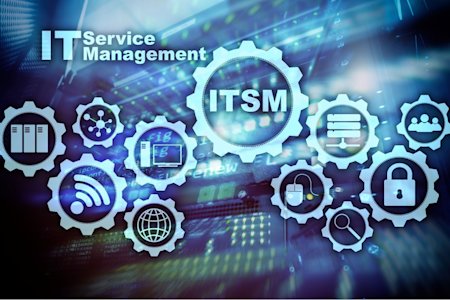Gerenciar os serviços de TI de forma eficaz é essencial para o sucesso das empresas modernas. O Gerenciamento de Serviços de TI (ITSM) fornece uma abordagem estruturada para alinhar os serviços de TI com as metas de negócios, ajudando as organizações a melhorar a eficiência, a qualidade do serviço e o gerenciamento de custos. Neste guia, vamos explicar o que é ITSM, porque é importante, os principais processos envolvidos e como estruturas como ITIL e ferramentas como Splashtop podem melhorar os teus esforços de gestão de serviços de TI.
Gerenciamento de serviços de TI (ITSM) - Obtenha Suporte de TI Seguro
Definição de ITSM
O Gerenciamento de Serviços de TI (ITSM) é a abordagem estratégica para projetar, fornecer, gerenciar e melhorar a maneira como as empresas usam os serviços de TI. Foca-se em alinhar os serviços de TI com as necessidades específicas da organização, com o objetivo de melhorar a eficiência, a qualidade do serviço e as operações de negócios. O ITSM não é uma ferramenta ou processo único, mas sim um conjunto de práticas que permite às empresas gerenciar e fornecer serviços de TI de forma estruturada. Ao fornecer uma estrutura para garantir que os processos, as pessoas e a tecnologia certos estejam em vigor, o ITSM ajuda as organizações a alcançar o sucesso operacional.
Porque o ITSM é Importante?
O Gerenciamento de Serviços de TI é essencial para as empresas modernas, pois contribui diretamente para a eficiência operacional e a qualidade do serviço. Com um processo de ITSM estruturado, as empresas podem garantir que os serviços de TI estejam alinhados com seus objetivos, gerando mais valor de seus investimentos em tecnologia.
Veja por que o ITSM é crucial:
Eficiência Operacional: O ITSM ajuda as empresas a simplificar seus processos, permitindo uma resolução de problemas mais rápida e um gerenciamento de recursos mais eficiente.
Melhoria da Qualidade de Serviço: Ao padronizar os processos de TI, o ITSM garante uma prestação de serviços consistente, reduzindo erros e melhorando a satisfação do cliente.
Alinhamento de Negócios: O ITSM promove um melhor alinhamento entre os serviços de TI e os objetivos gerais da empresa, ajudando as organizações a usar a tecnologia como uma vantagem competitiva.
Controle de Custos: Com práticas de ITSM bem implementadas, as empresas podem gerenciar recursos de forma mais eficaz, reduzindo os custos associados à prestação de serviços de TI.
ITSM vs. ITIL vs. DevOps
Embora ITSM, ITIL e DevOps sejam estruturas ou metodologias para gerenciar serviços de TI, eles têm focos diferentes:
O ITSM é uma abordagem mais ampla que engloba uma série de práticas destinadas a gerenciar serviços de TI de ponta a ponta, desde o projeto inicial do serviço até a entrega contínua do serviço.
ITIL (Information Technology Infrastructure Library) é uma estrutura específica dentro do ITSM, fornecendo orientação detalhada sobre como implementar práticas de ITSM. A ITIL concentra-se na melhoria contínua e na entrega de valor ao cliente através de uma gestão eficaz dos serviços de TI.
O DevOps, por outro lado, é uma metodologia que combina equipes de desenvolvimento e operações para acelerar os processos de desenvolvimento e implantação de software. Enquanto ITSM e ITIL se concentram mais no gerenciamento de processos, o DevOps enfatiza a colaboração e a automação para alcançar uma entrega mais rápida de atualizações de software e novos recursos.
Estas abordagens não se excluem mutuamente. Na verdade, muitas organizações usam uma combinação de ITSM, ITIL e DevOps para gerenciar seus serviços de TI de forma eficaz.
Principais Processos de ITSM
O Gerenciamento de Serviços de TI (ITSM) engloba uma variedade de processos principais que ajudam as empresas a gerenciar seus serviços de TI de forma eficiente. Aqui estão alguns dos processos de ITSM mais importantes:
Gestão de Incidentes
O gerenciamento de incidentes se concentra em restaurar a operação normal de serviço o mais rápido possível após uma interrupção não planejada. O objetivo é minimizar o impacto nas operações de negócios, garantindo que os serviços estejam disponíveis e funcionando sem problemas. Esse processo envolve a identificação, registro e resolução de incidentes por meio de fluxos de trabalho predefinidos.
Gestão de Problemas
Enquanto o gerenciamento de incidentes lida com problemas imediatos, o gerenciamento de problemas se concentra na identificação das causas profundas de problemas recorrentes para evitar incidentes futuros. Essa abordagem proativa ajuda as organizações a eliminar problemas sistêmicos e melhorar a confiabilidade de seus serviços de TI ao longo do tempo.
Gestão da Mudança
O gerenciamento de alterações garante que todas as alterações nos serviços de TI — seja adicionando novos recursos, corrigindo bugs ou atualizando sistemas — sejam gerenciadas de forma controlada e sistemática. Esse processo visa reduzir as interrupções de serviço causadas por alterações mal executadas, garantindo que os serviços de TI continuem funcionando sem problemas durante atualizações ou modificações.
Gestão de Pedidos de Serviço
Esse processo lida com o tratamento de solicitações de usuários para serviços como instalação de software, concessão de acesso ou atualização de equipamentos. Ele fornece uma abordagem estruturada para gerenciar e atender às solicitações de serviço, garantindo que elas sejam resolvidas em tempo hábil e atendam às expectativas dos usuários.
Gerenciamento de Ativos e Configurações
O gerenciamento de ativos e configurações está focado em identificar, rastrear e gerenciar ativos de TI, de hardware a software, durante todo o seu ciclo de vida. Esse processo garante que as empresas tenham visibilidade sobre o status e a localização de seus ativos de TI, facilitando a manutenção de um inventário atualizado e o gerenciamento eficaz das configurações.
Esses principais processos de ITSM ajudam as empresas a manter o controle sobre seus ambientes de TI, melhorando a eficiência e a prestação de serviços em todos os setores.
Benefícios de Processos ITSM Eficientes
A implementação de um processo de ITSM eficiente pode oferecer uma ampla gama de benefícios para as empresas. Aqui estão algumas das principais vantagens:
Maior Eficiência Empresarial: Ao simplificar as operações de TI, o ITSM ajuda a reduzir as ineficiências, permitindo que as equipes respondam aos problemas de forma mais rápida e eficaz.
Redução de Custos: Uma estrutura de ITSM bem estruturada ajuda as empresas a otimizar o uso de recursos, reduzindo custos operacionais e evitando gastos desnecessários.
Qualidade de Serviço Melhorada: Os processos de ITSM garantem que os serviços sejam entregues de forma consistente, levando a uma melhor satisfação do cliente e a menos interrupções de serviço.
Conformidade: O ITSM pode ajudar as empresas a aderir aos requisitos normativos, fornecendo documentação e processos claros para o gerenciamento de serviços de TI.
Gestão de Riscos: O ITSM ajuda a identificar riscos potenciais e os mitiga implementando processos estruturados de gerenciamento de incidentes e problemas.
Melhor Tomada de Decisão: Com dados precisos sobre o desempenho de TI e a alocação de recursos, as organizações podem tomar decisões informadas que se alinham com seus objetivos de longo prazo.
Maximizando a Eficiência por meio do Gerenciamento de Serviços de TI
O Gerenciamento Eficiente de Serviços de TI (ITSM) tem tudo a ver com garantir que os serviços de TI sejam fornecidos de uma forma que otimize a produtividade e minimize as interrupções. Um componente-chave dessa eficiência é a automação de tarefas repetitivas, como registro de incidentes, atribuição de tíquetes e atendimento de solicitações de serviço. A automação agiliza processos, permitindo que as equipes de TI se concentrem em tarefas mais estratégicas e reduzindo o risco de erro humano.
Outro aspeto crucial da maximização da eficiência em ITSM é fornecer suporte rápido e eficaz aos usuários finais. É aqui que as soluções de suporte remoto de TI, como o Splashtop SOS, entram em ação. Com o Splashtop SOS, as equipas de TI podem fornecer assistência remota a pedido, solucionando e resolvendo problemas em tempo real. Isso reduz o tempo de inatividade e aumenta a produtividade, garantindo que as interrupções de serviço sejam resolvidas rapidamente, sem a necessidade de uma visita ao local. A integração de ferramentas de suporte remoto em estruturas de ITSM não apenas simplifica as operações, mas também melhora a experiência do usuário final, já que os problemas podem ser resolvidos quase instantaneamente, independentemente da localização.
Ao combinar automação, suporte remoto e processos eficientes, as organizações podem maximizar os benefícios de suas estratégias de ITSM. Isso permite uma melhor qualidade de serviço, tempos de resolução mais rápidos e maior produtividade da equipe de TI, o que contribui para uma infraestrutura de TI mais eficiente e resiliente.
Transformando as Operações de Negócios: O Impacto do ITSM em Vários Setores
O Gerenciamento de Serviços de TI (ITSM) tem um profundo impacto na forma como as empresas operam em diferentes setores. Ao simplificar os processos de TI, melhorar a qualidade do serviço e garantir o alinhamento com os objetivos de negócios, o ITSM está transformando as operações em setores como saúde, finanças, manufatura e muito mais.
Veja como o ITSM está fazendo a diferença em todos os setores:
Saúde
Na área da saúde, o ITSM ajuda a gerenciar ambientes de TI complexos que oferecem suporte ao atendimento ao paciente, registros médicos e conformidade com normas regulamentares. Ao implementar processos eficientes de gerenciamento de serviços de TI, as organizações de saúde podem garantir que seus sistemas críticos permaneçam operacionais, reduzindo o tempo de inatividade e aumentando a segurança do paciente.
Finanças
O setor financeiro depende fortemente de serviços de TI para gerenciar transações, dados de clientes e conformidade regulatória. O ITSM permite que as instituições financeiras gerenciem riscos, garantam a segurança dos dados e forneçam serviços ininterruptos aos clientes, ao mesmo tempo em que cumprem requisitos regulatórios rigorosos.
Produção
No setor de manufatura, o ITSM ajuda a otimizar os processos de produção, garantindo que os sistemas de TI que suportam a automação e o gerenciamento da cadeia de suprimentos estejam funcionando de forma eficiente. Com práticas eficazes de ITSM, os fabricantes podem reduzir o tempo de inatividade, manter os cronogramas de produção e melhorar a eficiência geral de suas operações.
Educação
As instituições de ensino estão cada vez mais dependentes de serviços de TI para gerenciar plataformas de aprendizagem on-line, dados de alunos e processos administrativos. O ITSM fornece uma estrutura para manter esses serviços, garantindo que as organizações educacionais possam fornecer acesso ininterrupto a recursos para alunos e funcionários.
Estruturas ITSM
O Gerenciamento de Serviços de TI (ITSM) é construído com base em várias estruturas que fornecem abordagens estruturadas para gerenciar serviços de TI. Essas estruturas servem como guias para a implementação de práticas eficazes de ITSM, ajudando as empresas a alinhar suas operações de TI com os objetivos organizacionais. Abaixo estão algumas das estruturas ITSM mais populares:
ITIL (Biblioteca de Infraestrutura de Tecnologia da Informação)
O framework ITIL é um dos frameworks ITSM mais utilizados. Ele fornece um conjunto detalhado de práticas para o gerenciamento de serviços de TI que se concentra em alinhar os serviços de TI com as necessidades dos negócios. A ITIL promove a melhoria contínua do serviço e baseia-se em um ciclo de vida de cinco estágios: estratégia de serviço, design de serviço, transição de serviço, operação de serviço e melhoria contínua do serviço. Ao seguir o ITIL, as empresas podem otimizar seus processos de TI e melhorar a qualidade do serviço.
COBIT (Objetivos de Controle para Informação e Tecnologias Relacionadas)
COBIT é uma estrutura de governança de TI que se concentra no gerenciamento e governança de ambientes de TI corporativos. Embora cubra muitos aspetos do gerenciamento de TI, o COBIT enfatiza a garantia de que os sistemas de TI estejam alinhados com os objetivos de negócios, os riscos sejam minimizados e a conformidade com os requisitos regulatórios seja mantida. O COBIT é comumente usado por organizações que exigem forte controle e governança sobre seus serviços de TI.
Seis Sigma
O Six Sigma é uma metodologia baseada em dados focada em melhorar a qualidade dos processos, identificando e removendo as causas dos defeitos e minimizando a variabilidade. No contexto do ITSM, o Six Sigma pode ser aplicado para melhorar a eficiência e a qualidade dos processos de serviços de TI, garantindo que os serviços sejam entregues de forma consistente e com um alto padrão.
ISO/IEC 20000
A ISO/IEC 20000 é uma norma internacional para gerenciamento de serviços de TI, fornecendo diretrizes para estabelecer, implementar, manter e melhorar continuamente os processos de ITSM. Baseia-se nos princípios ITIL, mas enfatiza a conformidade com padrões reconhecidos mundialmente. As organizações que obtêm a certificação ISO/IEC 20000 demonstram seu compromisso em fornecer serviços de TI de alta qualidade que atendam às melhores práticas internacionais.
Cada uma dessas estruturas oferece informações exclusivas sobre o gerenciamento de serviços de TI, e as empresas geralmente adotam uma combinação dessas estruturas com base em suas necessidades específicas e requisitos do setor.
O que Considerar ao Implementar o ITSM
A implementação do Gerenciamento de Serviços de TI (ITSM) pode ser um processo complexo, mas com planejamento e consideração cuidadosos, as empresas podem garantir uma transição suave e maximizar os benefícios do ITSM. Aqui estão alguns fatores-chave a ter em mente durante a implementação:
1. Defina Objetivos Claros
Antes de iniciar o processo de implementação do ITSM, é essencial definir claramente os objetivos e metas. Quais são os principais pontos problemáticos em suas operações de TI atuais? Como o ITSM abordará essas questões? Ter metas bem definidas orientará o processo de implementação e ajudará a medir o seu sucesso.
2. Ganhe a Adesão das Partes Interessadas
A implementação bem-sucedida do ITSM requer o apoio de várias partes interessadas, incluindo a alta administração, as equipes de TI e até mesmo os usuários finais. É crucial comunicar os benefícios do ITSM a todas as partes envolvidas e garantir que elas entendam como ele melhorará a prestação de serviços e a eficiência operacional. Essa adesão ajudará a impulsionar a adoção em toda a organização.
3. Comece com um Piloto
Em vez de implantar o ITSM em toda a organização de uma só vez, considere começar com um projeto piloto. Escolha um departamento ou processo de TI específico para implementar o ITSM e use isso como uma experiência de aprendizado. O feedback desta fase inicial pode ser inestimável para refinar os processos antes de uma implementação em grande escala.
4. Alocação de Recursos
A implementação do ITSM requer os recursos certos, tanto em termos de pessoal quanto de tecnologia. Certifique-se de que sua equipe tenha as habilidades e a experiência necessárias para gerenciar processos de ITSM. Além disso, invista nas ferramentas e softwares certos que darão suporte ao gerenciamento eficiente de serviços de TI.
5. Foco na Melhoria Contínua
O ITSM não é um projeto único, mas um processo contínuo. Uma vez implementado, é importante monitorar continuamente o desempenho dos processos de ITSM e identificar áreas para melhoria. Incentivar uma cultura de melhoria contínua através da revisão regular dos indicadores-chave de desempenho (KPIs) e da recolha de feedback das partes interessadas.
6. Gerencie a Mudança de Forma Eficaz
A introdução do ITSM exigirá alterações nos fluxos de trabalho e processos existentes, que às vezes podem encontrar resistência. Um processo de gestão de mudanças bem estruturado é essencial para mitigar interrupções e garantir que os funcionários estejam confortáveis com novos procedimentos. Fornecer treinamento e comunicação clara sobre os benefícios do ITSM pode facilitar essa transição.
Ao considerar esses fatores, as empresas podem estabelecer a base para uma implementação bem-sucedida de ITSM, gerando melhorias na eficiência, qualidade do serviço e alinhamento com os objetivos de negócios.
Como a Splashtop Apoia a Tua Estratégia ITSM
A Splashtop pode desempenhar um papel importante na melhoria da Gestão de Serviços de TI (ITSM), oferecendo soluções de apoio remoto que permitem às equipas de TI gerir os serviços de forma eficiente. Com o Splashtop, o teu pessoal de TI pode fornecer suporte remoto a pedido para resolver rapidamente incidentes e pedidos de serviço, melhorando os tempos de resposta e minimizando o tempo de inatividade. Essa flexibilidade é crucial para o ITSM, permitindo que sua equipe solucione e resolva problemas em várias plataformas remotamente.
A segurança é também uma prioridade máxima, com a encriptação robusta e a autenticação multi-fator do Splashtop a manterem as sessões remotas seguras. Ao fornecer a flexibilidade para suportar dispositivos a partir de qualquer lugar, a Splashtop ajuda a reduzir os custos operacionais e a simplificar os processos de TI, facilitando às empresas o alinhamento dos seus serviços de TI com os objetivos organizacionais.
Saiba mais e descubra como o Splashtop pode complementar a sua estratégia ITSM e melhorar as suas capacidades de suporte remoto de TI.





